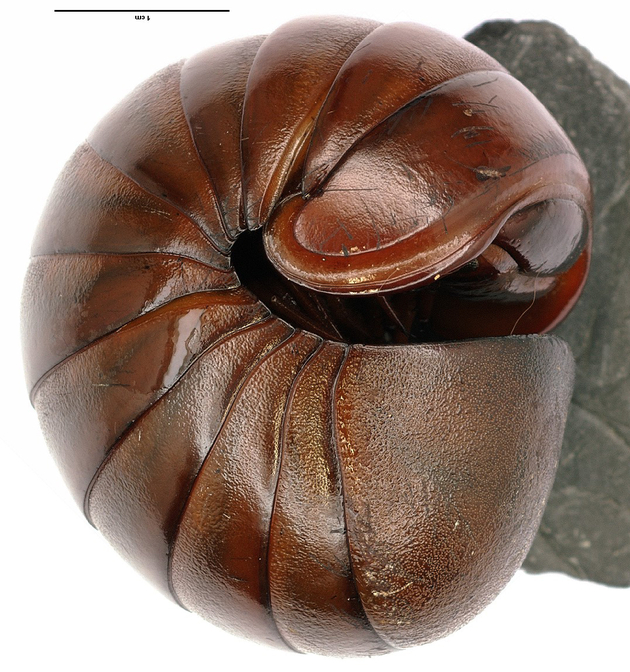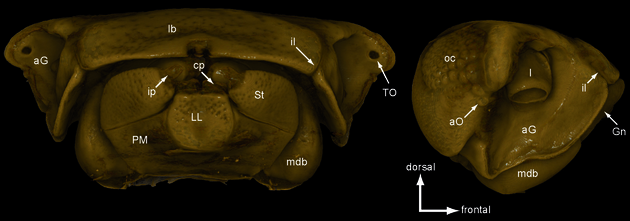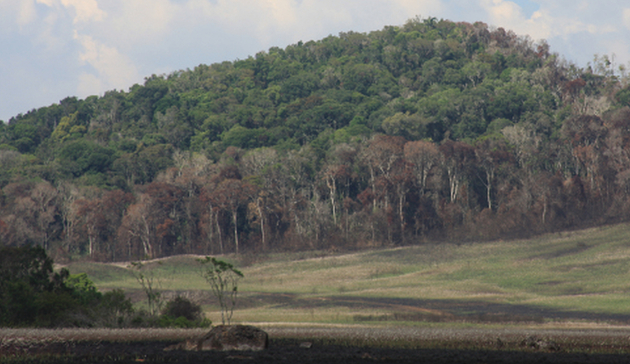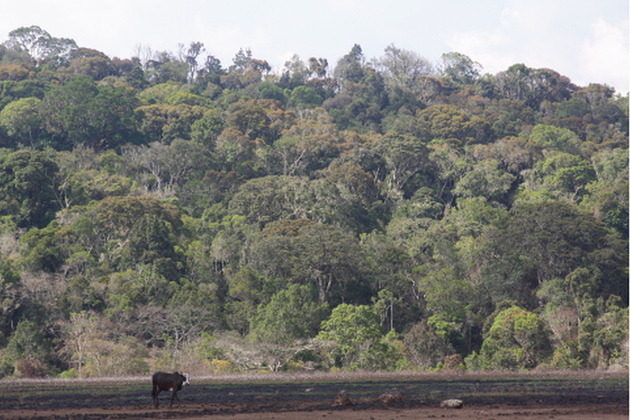Madagascar, a tropical island off the coast of east Africa, is home to many plants and animals found nowhere else in the world. The invertebrates found on Madagascar are as spectacular as the island's charismatic lemurs and Baobab trees. The millipede fauna is particularly impressive. Madagascar is home to the giant pill-millipedes. Pill-millipedes have the ability to roll into a sphere and these “giants” (by millipede standards) can reach the size of a baseball when rolled-up. The millipedes on Madagascar have been around since the Cretaceous period (> 66 million years ago), the Age of the Dinosaurs, when India and Madagascar were part of the same continent. Certain characters known from Madagascar's millipedes, such as the ability to produce sounds in both males and females, are only shared with related species from South India. This shows that species found in Madagascar and India evolved together when Madagascar and India were united.
Christina Sagorny, a student at the University of Bonn in Germany, and Thomas Wesener of the Zoological Research Museum Alexander Koenig - Leibniz Institute for Animal Biodiversity, have described two new species of giant pill-millipedes from the remote forest of Bemanevika in northern Madagascar. The new species were published in the journal Zootaxa. The millipedes were collected during general inventory programs by the Field Museum in Chicago. Bemanevika contains five volcanic crater lakes and isolated patches of montane forests surrounded by pseudosteppe grass lands. One of these lakes is the only remaining refuge of the planet’s rarest duck, the Madagascar pochard, rediscovered in 2006.
The newly described species are just known from a few individuals. To document the specimens, micro-CT imaging (the kind doctor’s use on humans but on a smaller scale) was used to explore the millipede’s internal head anatomy. This is only the second time this cutting-edge technique has been used in millipede taxonomy.
The scientists carried out a genetic study to identify that the males and females of the new species, Zoosphaerium bemanevika (Latin for 'Bemanevika's Giant Ball Animal'), were indeed the same species. The females and males look different: the females are larger than a golf ball or small plum, while the males are much smaller, and about the size of a marble or a small cherry. The second species, Zoosphaerium minutus (Latin for 'Small Giant Ball Animal'), is—as the name suggests—a miniscule species of giant pill-millipedes. Both the males and females of Z. minutus are only slightly larger than a pea when rolled-up. The two new Bemanevika species are not closely related to one another; the genetic distances between the two species suggest that they already separated from a common ancestor millions of years ago.
Both species are restricted to tiny forest fragments. Their closest known relatives are not found in the area, but instead one hundred kilometres away in the Marojejy Mountain and rainforests on the east coast of Madagascar. This discovery highlights the importance of preserving habitats of Madagascar's rare species, even if they are small patches, because a species can be lost forever. While the forest where the new species are located is officially protected, the people around the area depend on the surrounding grassland as a pasture for their Zebu cows. Each year the grassland is burned and the fires spread to the forest edge, incrementally decreasing the size of the remaining forest fragments each year.
The loss of habitat affects all rare invertebrates on Madagascar — many of which live in tiny forest fragments. The conservation status of the species is detailed on the IUCN red list that provides conservation status and biological information on the species that are facing the highest risks of global extinction, among them numerous giant pill-millipedes from Madagascar. To address Madagascar’s extinction crisis, a recently launched program called the IPSIO network, which is organized by the California Academy of Sciences and funded by CEPF, seeks to bring attention to the importance and role of these unique invertebrates in the region.
Abbildungen
1: The giant female of Bemanevika's giant pill-millipede, Zoosphaerium bemanevika. Photo: Thorsten Klug, Copyright: ZFMK 2017
2: CT scan of the head of Zoosphaerium bemanevika. (©) Christina Sagorny, ZFMK 2017
3: The habitat of the two new species. Small fragments of rainforest in the Bemanevika area. The damaged trees at the forest edge are clearly visible. © Achille P. Raselimanana.
4: The reason for the damaged trees. The surroundings of the forest fragments are used as pasture of Zebu cattle and are annually burnt. Each fire destroys a few meters of forest, letting the already small fragments to shrink further. The grassland has no humus layer and is a hostile environment to most millipedes. © Achille P. Raselimanana.
Contact:
Dr. Thomas Wesener
Head of Section Myriapoda
Curator
Tel: +49 228 9122-425
Mail: t.wesener [at] leibniz-zfmk.de
Christina Lara Sagorny
Tel: +49 228 9122-423
E-Mail: s6chsago [at] uni-bonn.de
Source: Sagorny, C. & Wesener, T. (2017). Two new giant pill-millipede species of the genus Zoosphaerium endemic to the Bemanevika area in northern Madagascar (Diplopoda, Sphaerotheriida, Arthrosphaeridae). Zootaxa, 4263 (2): 273–294. http://doi.org/10.11646/zootaxa.4263.2.4
--------------
Zoological Research Museum Alexander Koenig – Leibniz-Institute for Animal Biodiversity (ZFMK) is an independent research institute. The focus of research is on performing an inventory of the zoological species diversity on earth, on the analysis of changes in biodiversity as a result of environmental factors, and on evolutionary processes at the morphological and molecular levels. ZFMK furthermore explores the context of structure and function of ecological systems, advanced scientific methods, and the study of the history of science. The permanent exhibition “Our blue planet – the living network” offers a genuine nature experience based on naturalistic ecosystem displays.
The Leibniz Association combines 91 independent research institutes. Their focus ranges from the natural, engineering, and environmental sciences to the humanities and the business, space, and social sciences. The Leibniz institutes focus on relevant social, economic, and ecological issues. They perform knowledge-oriented and applied research (also among the cross-disciplinary Leibniz research alliances), are or support scientific infrastructures, and offer research-based services.
The Leibniz Association mainly focuses on knowledge transfer, especially with the Leibniz research museums. It advises and informs those in politics, science, industry, and the general public. The Leibniz institutes collaborate closely with universities (e.g., as part of the Leibniz scientific campuses), industry, and other domestic and foreign partners. They are subject to a transparent and independent evaluation procedure. Due to their national importance, the institutes of the Leibniz Association are supported jointly through federal and state funding. The Leibniz institutes employ approximately 18,600 people, 9,500 people of which are research scientists. The total budget of the institutes is more than 1.7 billion euros.











